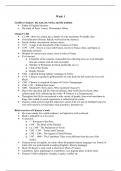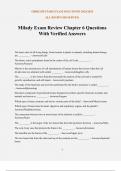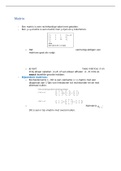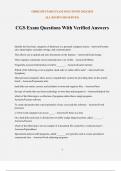1. Introduction: bacteriophages
• Bacteriophages
o = viruses that infect bacteria
o Structure: capsid with genetic material, tailed (tail fibers, tail spikes) with injecting mechanism
o Kenmerk: bacteriophages are highly selective/specific for certain hosts (*)
• Lytic phage infection cycle: lytic phage
o 1) Adhesion and genome injection
▪ 1) Phage tail recognize specific receptors on target bacterial cellwall vb LPS, pilli, other OM
proteins (*) → reversible & irreversible binding on the bacterial surface
▪ 2) Then structural changes happen in phage particle → injection of genetic material
o 2) Expression of early genes
▪ Within minutes, early genes are expressed & early proteins are formed → early proteins
interact with the cell content vb with protein complexes → bacterial metabolism is
converted into virus producing machine
o 3) Genome replication of the bacteriophage
o 4) Generation & assembly of new phage particles
o 5) Release of new phages, by the action of enzymes degrading the cellwall
o Conclusion: 1 phage infecting a bacteria, self-amplificates, resulting in many more new phages
▪ Gevolg: local increase of phage particles at site of infection (phage therapy) or site of
diagnostic (diagnosis)
o Conclusion: bacteriophage infection happens within minutes-hours
• Lytic phage infection cycle: 1 step growth curve
o = Phages per cell vs time after infection (graph), including
▪ 1) Latent period
▪ 2) Burst size: the number of phages per cell formed, ifv time
o Dependent on
▪ 1) Specific growth conditions
▪ 2) The situation by which bacteria and phages coexist in an environment
▪ Vb: difference when using nutrient rich media ecological level
• Dynamic equilibrium/balance between bacteriophages & host cells/bacteria
o = the interaction between a bacteriophage & host cell may be parasitically , but will never be a full
eradication
▪ → especially in case of temperate phages (less with lytic phages)(zie hieronder)
▪ → this ecological struggle is reflected in diagnostics, microbial resistance development
• Lysogenic phage infection cycle: temperate phage
o 1) After genome injection, the phage’s genome can integrate into the bacterial genome
▪ → prophage = are bacteriophage genomes integrated into the host genome
▪ → gives a mutualistic interaction: benefit for both the bacteria & the phage
• 1) Phage genome is stably maintained & duplicates with the host genome
• 2) Bacteria has increasing virulence, by production of proteins encoded by the
prophage vb cholera toxin
• 3) Horizontal gene transfer of bacterial genes, happens through transduction, to
other bacteria → gives extra selection benefits to other bacteria
o 2) When stress (vb DNA stress), the mutualism ends → the prophage excises and enters the lytic
cycle → lysis of the host
2. Detection and typing of bacteria
1
,• Detection and typing of bacteria
o Bacteriophages are highly specific: most viruses will only attach to and infect a specific host
o Phage-typing
▪ = exploits this relationship & uses the virus as ‘tags’ to identify MO in the environment at the
sub-species level
▪ = to detect bacteria, bacterial pathogens etc. by exploiting phage specificity
o Host range of phage-typing: sub-species level, highly specific
▪ = within a species, the phages can vb only infect a subset of the isolates (adv & disadv)
▪ broad spectrum of antibiotics
o Phage-typing toepassing:
▪ 1) diagnostics: use a stable bank of phages to spot unknown bacteria & identify them at
subspecies level
▪ 2) fluorescently stained viruses (YOYO-1 or POPO-1) can be used as probes to label, identify,
and quantify specific strains of bacteria & cyanobacteria in mixed microbial assemblages.
• Major aspect of diagnostic assay: sensitivity vs specificity
• Example1: Luciferase Reporter Phage / Reporter phage assay
o 1) Phage infection:
▪ 1) Reporter genes (Lux, luc, ina or gfp) are inserted in the phage genome (engineered phage)
▪ 2) The recombinant DNA is packaged into phage particles
▪ 3) Reporter phage are mixed with the sample, but only infect susceptible host cells
• → removing the need for purification of the organism before detection
o 2) Phage replication: after infection, reporter phage genomes are replicated & reporter gene is
expressed from phage genome
o 3) Signal detection reporter protein accumulates → expression of reporter gene can be detected
o Sensitivity here = dependent on the amount of reporter protein present & capacity to detect it
o Specificity here = phage specifically recognizing its bacterial target
• Example2: Dual Phage Technology / Dual Phage Detection Assay (to improve specificity)
o → 2 different transducing phages: which transduce resistance genes to 2 different AB into a host cell
o → Antibodies chemically cross-linked to the 2 transducing phages
o 1) The antibody-labelled phages are mixed with the target antigen & allowed to bind
▪ Antibodies binding to the same target antigen cross-links the 2 transducing phages
o 2) This sample is mixed with host cells
▪ Only phages bound together via the target antigen, are brought in physical proximity, to co-
infect the host cells
▪ Sample mixing happened at a suitable dilution rate to ensure that random co-infection of
host cells is rare
o 3) Infected host cells are then grown on agar plates containing both antibiotics to select for only co-
infected cells
▪ Positive result = colonies on the agar plate
o Ab are not displayed on the phage, because full Ab’s are difficult to assemble → crosslink !
▪ only single chain camel Ab can be displayed on phages
o Increase of specificity by this assay because:
▪ 2 different phages with antibodies to different epitopes of the target antigen are used =
double detection selection method
• Other aspects of diagnostic assays: cost, time, reproducibility, stability
o Time: Mycobacterium tuberculosis grows very slow (up to 10 weeks) → to avoid this, use the PAA !!
• Example3: Phage Amplification Assay (PhaB assay) (increase in sensitivity??)
o → No modification of phages are required
o → There are phages infecting both M tuberculosis & M tuberculum smegmatis (belongs to same
family but grows rapidly), which we can use!
2
, o 1) Phage infection: Phages are mixed with the sample to infect susceptible cells (M. tuberculosis
present in the sample)
o 2) Once phage have entered the eclipse phase, a virucide is added
▪ The virucide does not affect the target bacterium, but external phages which have not
infected cells are destroyed → phages that have successfully infected the host, survive
o 3) The virucide is then neutralized & the sample containing the infected cells is mixed with helper
cells (M. Smegmatis) that support phage replication
▪ Helper cells don’t need to be the same cell type as the target bacterium
o 4) The mixture is spread over agar plates & incubated to develop a lawn
o 5) Phages in the infected cell, finish their replication, lyse the host cell & progeny phage infect the
rapidly growing helper cells (M. Smegmatis) in the lawn → leading to plaque formation
▪ Can count the nr of plaques formed & do back calculation
▪ Back calculation: if burst size of our phage in M. Smegmatis is 20 & we have 100 plaques →
back calculate using these 1 step growth curves, how many M. tuberculosis were present in
the original sample (in a day or 2, because M. Smegmatis grows rapidly)
• = based on the progeny of the 1st amplification round (?)
• Not on market yet
• Basic qpcr, pcr tecniques as diagnostics ara ctually be used in sensitivity way
• so terms of diagnostics, the qpcr type assays to quantify the bacteria offer a standard approach , but
• dunno opname?
• Example4: Bacteriophage Quantum Dots (to improve the sensitivity further) (not on market)
o = high-sensitivity bacterial detection using biotin-tagged phage and quantum-dot nanocomplexes
o Quantum dots
▪ = semiconducting nanocrystals ranging from 2-10 nanometers (10-50 atoms) in diameter
▪ → They strongly absorb light in the near UV range
▪ → They re-emit visible light with a color determined by both their size & surface chemistry
o 1) Phage Display using a biotinylation peptide fused to capsid protein (can become biotinylated)
o (2) After infection of the target bacterium (sample) with the phage → lysis
o (3) After lysis, the target bacterium (hosts) biotin-ligase protein will biotinylate the progeny phages
o (3) Then Quantum Dots conjugated to streptavidin are applied & interact with the biotinylated
progeny phages → labelled phages, and thus labelled bacteria are visible due to light emission of QD
o Kenmerken
▪ Detection limit 10 cells/ml
▪ 100 fold signal boost in 1h
o Increase of sensitivity by this assay because:
▪ → It uses the phage amplification step to get to low detection limits → so the light signal will
boost as time continues (more amplification)
o How do we produce phages that display the biotinylation peptide, but that not have been
biotinylated before by the production host?
▪ → by performing a KO of the host biotin-ligase protein in the production strain
3. Phage display and applications in antigen detection (no course material, just reminder)
• The Phage Display System
o Utilizes bacteriophage T7, which expose peptides fused to a capsid protein (by fusion of the coding
sequence of the peptide to capsid gene (or to other genes and displayed on other protein))
o Goal: way to find protein-protein interactions between exposed peptide & target protein in the well
o Kenmerken:
▪ Exposed polypeptides are accessible
▪ Viral particles are stable
▪ Amplification possible
3
, ▪ Protein exposed (on the phage) and gene (inside the phage) are linked
o Traditional exposition using filamentous ssDNA phage M13 (zie ppt)
• Application of phage display: Tissue-specific peptide identification
o 1) Extensive phage libraries, each displaying different peptides → injection in mouse
o 2) Then you can see if there are certain phage particles (& their peptides) specifically recognizing
certain types of tissues vb binding to receptors on mouse lung → peptide sequencing
4. Bacteriophages as vaccins / DNA vaccin
• 1) Bacteriophages as vaccins (protein vaccins)
o 1) Bacteriophages exposing an antigen peptide originating from the disease-causing microorganism
are injected into the blood stream (= phage display)
o 2) B cells in the blood stream respond to the antigen by producing antibodies & memory cells
o 3) The antibodies bind to the antigen to "neutralize"or inactivate it (so also when exposed again)
o Due to its innate immunogenic properties, the proteins from the phage particles act as natural
adjuvant, thus stimulating and improving the immune response!
o Exposition (phage display) through
▪ 1) transcriptional fusion of coat protein to the coding sequence of the antigen
▪ 2) or by artificial conjugation to phage surface (e.g. galactose, succinic acid)
o Advantage: these phage particles are very cheap to produce & stable
• 2) Bacteriophages as DNA-vaccins (DNA vaccins)
o DNA-vaccination (or DNA plasmid vector vaccination)
▪ = the vaccin carries the genetic material encoding protective antigens → the antigen can
then be produced inside the host cell → which stimulate a cell-mediated immune response
(via the MHC1 pathway) → which provide protection against pathogens
▪ = carries the genetic code for a piece of pathogen of tumor antigen
o 1) The plasmid vector is taken up into cells and transcribed in the nucleus
o 2) The single stranded mRNA is translated into protein in the cytoplasm.
o 3) The DNA vaccine-derived protein antigen is then degraded by proteosomes into intracellular
peptides.
o 4) The vaccine derived-peptide binds MHC class I molecules.
o 5) Peptide antigen/MHC I complexes are presented on the cell surface, binding cytotoxic CD 8+
lymphocytes, and inducing a cell-mediated immune response.
o Advantage:
▪ Cheaper & easier to produce than protein vaccins
▪ Packaging the DNA into phage particles improves the DNA stability & uptake
o Disadvantage:
▪ 1) less advense effect
▪ 2) induction of cellular and humoral immune system
▪ 3) less efficient in large animals => resolving these problems increase cost & technical issues
o Opm: Since DNA vaccines generate cell-mediated immunity, the hope is that they will be effective
against some difficult viruses where standard vaccines have failed to work.
• Bacteriophages as DNA-vaccins
o Cloning of DNA vaccines into bacteriophages (e.g. lambda, T7, M13)
▪ gene under control of eukaryotic promoter (e.g. CMV)
▪ DNA is packaged in vitro
▪ easy propagation in an E. coli host
▪ phage protein coat protects the DNA
▪ phage (with the DNA) is taken up by antigen presenting cells
o In Rabbits: lambda –HBsAg (2 µg DNA) (linear pRcCMV-HBs(S)
o Kenmerken:
4











